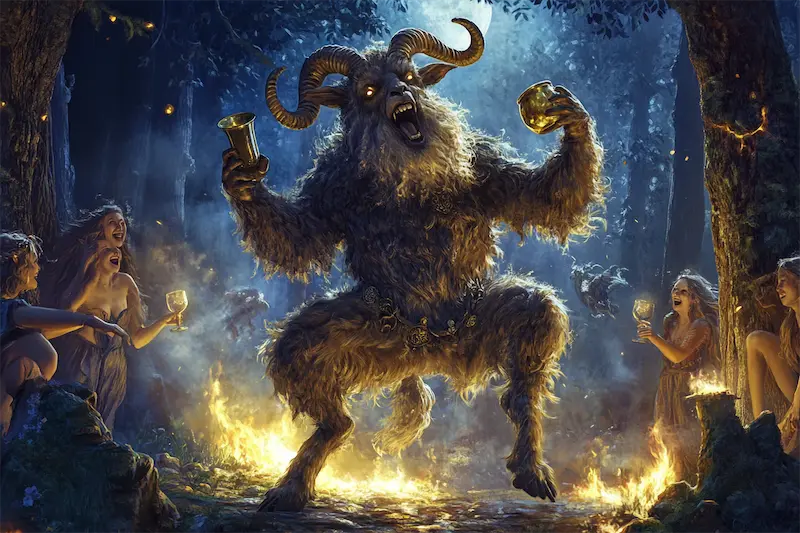What Is a Satyr?
A Satyr, also known as a wild man of the woods in Greek mythology, is a half-human, half-goat creature that embodies primal instincts, raw desire, and the joy of living. As followers of the wine god Dionysus, Satyrs are often depicted as merry, mischievous beings who love dancing, music, and reveling in the forest.
While not inherently evil, Satyrs are known for being unruly, pleasure-seeking, and lacking self-control. They represent the untamed, instinctual side of human nature—free from moral restraint. Their image plays an important role in ancient Greek art and continues to influence modern culture.
Appearance and Distinct Features of Satyrs
Satyrs have a hybrid appearance, combining human and goat features. Their upper body is human—usually male, muscular, and bare-chested—while their lower half features goat legs, hooves, and a short tail. They often have pointed ears, small horns, and shaggy hair.
Satyrs typically wear wreaths of ivy or flowers, carry a Pan flute, and have a wine jug in hand. Their mischievous expressions and playful grins reflect their carefree, wild nature. Everything about their look celebrates freedom, instinct, and rebellion against societal norms.
Origins and Symbolic Meaning of Satyrs
The origin of Satyrs dates back to early Greek folklore, where they were seen as forest spirits symbolizing fertility, vitality, and the untamed forces of nature. Over time, they became closely associated with Dionysus, the god of wine, agriculture, music, and divine madness.
As such, Satyrs came to symbolize:
- Physical desire and sensual pleasure
- Uncontrolled primal instincts
- Joyful living and living in the moment
- The tension between civilization and nature
In festivals like the Dionysia, Satyrs were popular characters in satyr plays—comic performances that mocked societal norms and embraced uninhibited expression through dance, music, and humor.
Traits and Powers of Satyrs
Satyrs are not known for physical strength or battle skills. Instead, their powers lie in their vitality, musical talent, and irresistible charm:
- Boundless energy: Satyrs can dance, sing, and party all night without tiring.
- Enchanting music: Their Pan flute can influence emotions, causing joy, ecstasy, or infatuation.
- Natural seducers: Satyrs are often portrayed as flirtatious and free-spirited, though sometimes seen as overly lustful.
- Deep connection to nature: They know the forests intimately—hidden paths, secret springs, and animal behavior.
Though mischievous, Satyrs are rarely considered dangerous. Instead, they reflect the untamed, joyful spirit of the natural world.
Famous Myths and Stories Featuring Satyrs
Satyrs appear in many Greek myths, especially in those involving Dionysus. Some notable figures include:
Pan – The Wild God of the Forest
While technically a god, Pan—half man, half goat—is considered the spiritual leader of Satyrs. He is the god of shepherds, wild nature, and rustic music. His Pan flute became a trademark instrument for Satyrs.
Silenus – The Wise Old Satyr
Silenus is one of the oldest Satyrs and serves as a teacher to Dionysus. Often depicted as drunk, Silenus paradoxically offers deep wisdom and prophetic insight despite his inebriated state.
Dionysus’s Eastern Journey
In Dionysus’s mythical journey to spread his cult to the East, Satyrs accompany him as loyal companions—bringing music, wine, and holy madness wherever they go.
Satyrs in Modern Culture
Satyrs remain a rich source of inspiration in literature, art, film, and video games. During the Renaissance, they were commonly featured in paintings and sculptures as symbols of instinct, desire, and the beauty of untamed nature.
In modern pop culture:
- In The Chronicles of Narnia, the character Mr. Tumnus (a Faun) resembles a Satyr.
- In Percy Jackson, Satyrs like Grover Underwood serve as loyal, magical companions.
- In games like God of War and Hades, Satyrs appear as quirky, sometimes dangerous figures.
They are also popular in theater, festivals, cosplay, and fantasy storytelling—symbolizing fun, rebellion, and creative freedom.
Related or Contrasting Mythical Creatures
Satyrs share many traits with Fauns from Roman mythology—also half-human, half-goat, but generally more gentle and in harmony with nature.
They stand in contrast to creatures like:
- Centaurs, who symbolize reason, discipline, and noble strength.
- Sphinxes, who represent intellect and moral challenge, while Satyrs seek pleasure without rules.
This contrast highlights the Satyr’s role as a symbol of uninhibited instinct rather than structured wisdom.
Satyrs in Feng Shui and Western Symbolism
In traditional Feng Shui, Satyrs are not common symbols due to their Western origin and unruly nature. However, in European garden design and art, Satyr statues may appear near fountains or natural settings to represent:
- Vitality and abundance
- Fertility and the joy of life
- Artistic freedom and sensual pleasure
For those who value freedom, creativity, and connection with nature, the Satyr can serve as a powerful decorative and symbolic element in personal spaces.
Conclusion
The Satyr, half-man and half-goat, is a captivating figure from Greek mythology. As a symbol of instinct, pleasure, and freedom, Satyrs offer a glimpse into the wild, unfiltered side of the human spirit.
Though mischievous and sometimes chaotic, they embody the energy of life, reminding us of the importance of joy, expression, and embracing our natural selves. For centuries, Satyrs have inspired art and culture, standing as enduring icons of raw vitality, artistic liberation, and the dance between impulse and morality.
